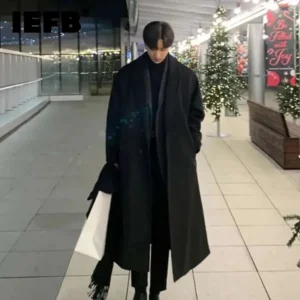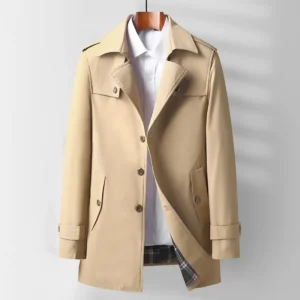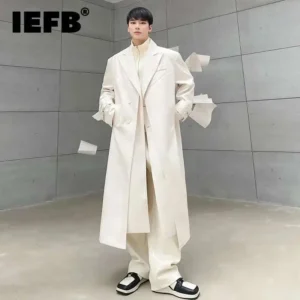1. Understanding the Light Topcoat: A Versatile Style Essential
The light topcoat stands as one of menswear’s most refined and versatile investments. Unlike its heavier overcoat cousins, a light topcoat typically weighs between 2-3 pounds and features a streamlined silhouette that works across multiple seasons. Made from materials like lightweight wool, wool-cashmere blends, or cotton gabardine, these coats offer protection without bulk.
What truly sets the light topcoat apart is its remarkable versatility. As a transitional piece, it bridges the gap between seasons when temperatures fluctuate but don’t require heavy winter protection. The right choosing right coat length creates a flattering silhouette that instantly elevates even the most basic outfit.
A quality light topcoat offers:
– Enhanced vertical lines that create a taller, more commanding appearance
– A sophisticated layer that transforms casual attire into something more intentional
– Practical protection against mild weather conditions
– Timeless style that transcends seasonal trends
Historically, light topcoats evolved from military greatcoats into refined civilian wear during the early 20th century. Today, they remain a cornerstone of sophisticated men’s style. Classic colors like camel, navy, charcoal, and light gray provide maximum versatility across your wardrobe, while premium materials ensure comfort and longevity.
With one well-chosen light topcoat from our men’s topcoats collection, you’ll discover endless styling possibilities that span from casual weekend wear to formal business attire.
2. Finding Your Perfect Light Topcoat
Selecting the right light topcoat begins with understanding proper fit. Your coat should accommodate layers underneath without appearing baggy or restricting movement. The shoulder seams should align with your natural shoulders, allowing comfortable arm movement without pulling or restriction.
When trying on a topcoat, pay attention to these key fit indicators:
– Shoulders should sit squarely without overhanging or pinching
– Sleeves should end at your wrist bone, showing ¼-½ inch of shirt cuff when arms are extended
– Overall length should hit between mid-thigh and just above the knee for optimal proportion
– You should be able to comfortably button the coat without any pulling or gapping
The weight of your topcoat matters significantly depending on your local climate. In milder regions, opt for 12-16 oz fabric weights that provide just enough warmth without overheating. For cooler climates, 16-20 oz fabrics offer additional protection while maintaining a sleek profile.
Quality construction reveals itself through careful examination. Look for fully-lined interiors, hand-stitched buttonholes, sturdy horn or corozo buttons, and clean, reinforced seams. These details not only enhance appearance but ensure your investment lasts for years.
For maximum versatility, neutral colors create the foundation of a sophisticated wardrobe. Navy, camel, and charcoal offer timeless appeal that works across both casual and formal settings. The mens coat length guide provides additional guidance on finding your ideal proportion based on height and build.
3. Essential Color Combinations for Light Topcoats
Mastering color coordination elevates your light topcoat from merely functional to truly stylish. Each topcoat color establishes a different foundation for creating harmonious outfits.
For camel topcoats, the warm neutral tone pairs exceptionally well with navy, burgundy, olive, and cream. This classic color creates striking contrast with darker elements while maintaining sophisticated balance. Try camel with navy trousers, a white shirt, and burgundy accessories for a timeless combination.
Navy topcoats offer remarkable versatility, working with virtually everything except similar navy shades. Create rich depth by pairing navy with burgundy, olive, light blue, or gray. A navy topcoat over a light gray suit with brown shoes creates an elegant business ensemble.
Gray topcoats from our mens grey overcoat collection serve as true neutrals that complement both cool and warm colors. Light gray works beautifully with navy, burgundy, and forest green, while charcoal pairs excellently with camel, light blue, or burgundy.
Consider these color strategies when building your outfits:
– Monochromatic: Varying shades of the same color family create sophisticated depth
– Complementary: Colors opposite on the color wheel (like navy and camel) create dynamic contrast
– Analogous: Adjacent colors (like navy and gray) offer subtle harmony
– Neutral foundation: Using neutral topcoat colors allows for more expressive shirt and accessory choices
Seasonally, lighter colors like camel and light gray transition well to spring, while deeper tones like navy and charcoal work year-round but especially shine in fall and winter.
4. Casual Light Topcoat Outfits: Elevating Everyday Style
Outfit 1: Weekend Coffee Run
Transform a simple errand into a style statement by pairing your light topcoat with a premium white t-shirt, selvedge denim jeans, and minimalist leather sneakers. The contrast between the refined topcoat and casual basics creates an effortlessly sophisticated look. Add a simple watch and sunglasses to complete this understated ensemble.
Outfit 2: Casual Friday
For relaxed office environments, layer your light topcoat over a fine-gauge knit polo in a complementary color. Pair with well-fitted chinos and suede chukka boots. This combination strikes the perfect balance between professional and approachable, working seamlessly from office to evening plans.
Outfit 3: Streetwear Fusion
Embrace contemporary style by wearing your light topcoat over a solid-colored hoodie. Complete the look with slim black jeans and high-top leather sneakers. This unexpected combination creates interesting textural contrast while maintaining a clean silhouette. The structured coat elevates the casual elements for a considered appearance.
Outfit 4: Smart Leisure
For weekend outings with friends, layer your topcoat over a lightweight cashmere sweater and pair with tailored joggers or drawstring trousers in a refined fabric. Complete with minimal leather sneakers or drivers. This outfit balances comfort and refinement perfectly for museum visits or casual dining.
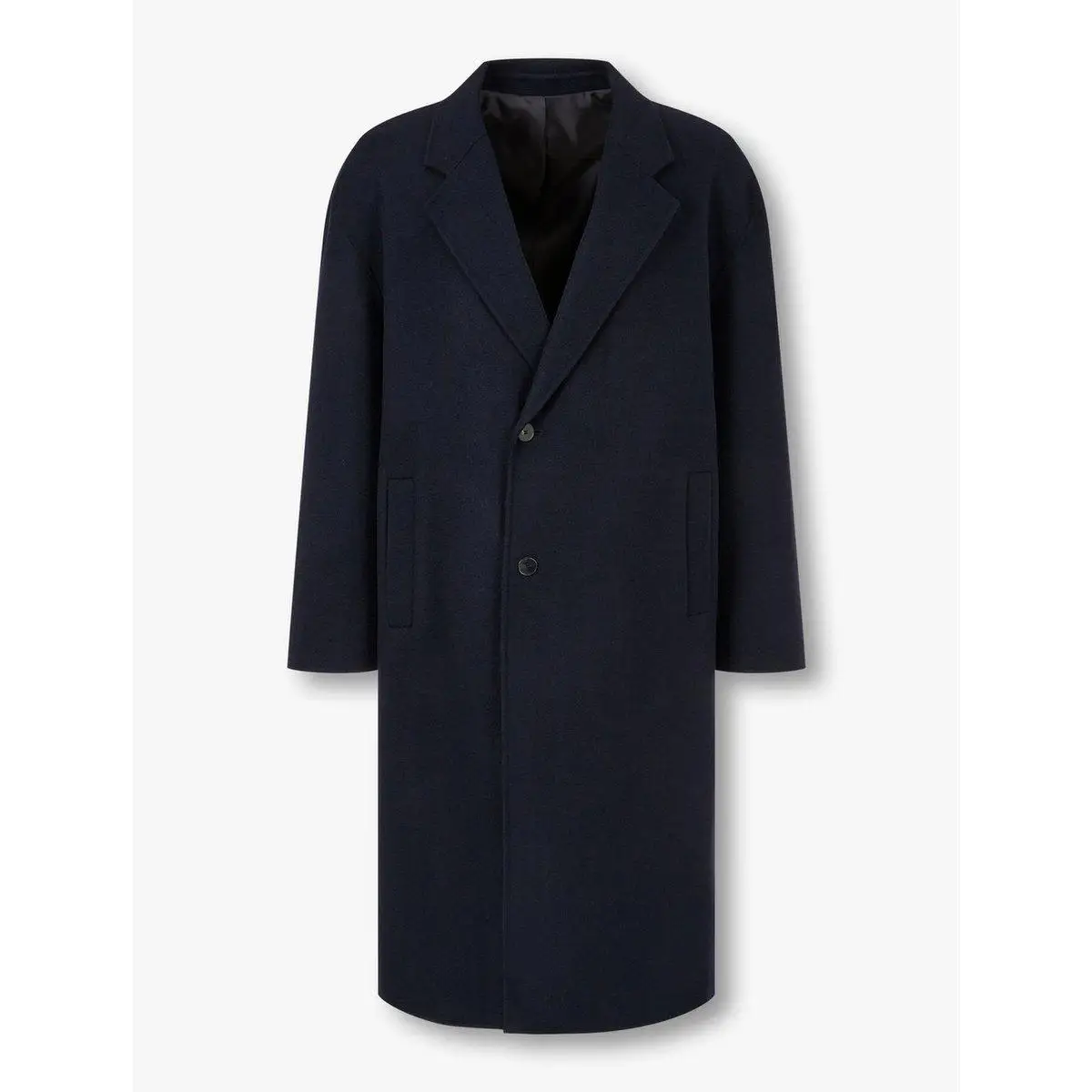
The key to casual topcoat styling lies in balancing proportions and maintaining quality throughout. Even when dressing down, ensure all elements appear intentional and well-maintained. Mastering casual looks with mens topcoats requires confidence in breaking traditional formal associations while maintaining the coat’s inherent elegance.
5. Smart-Casual Light Topcoat Combinations: Refined Yet Relaxed
Outfit 5: Creative Office
For creative professional environments, pair your light topcoat with a fine-gauge turtleneck sweater in a complementary tone. Add tailored wool trousers with a slight texture and complete with sleek Chelsea boots. This combination projects creative confidence while maintaining professional polish.
Outfit 6: Dinner Date
Make an impression on your next evening out by wearing your light topcoat over a crisp oxford button-down shirt, preferably with subtle texture. Dark indigo selvedge denim provides sophisticated contrast, while desert boots in suede add approachable refinement. This versatile combination works beautifully for restaurant dinners or theater outings.
Outfit 7: Weekend Gathering
For social gatherings with friends or family, layer your light topcoat over a lightweight merino crew neck sweater in a flattering color. Pair with textured chinos in a complementary shade and finish with leather loafers or drivers. This ensemble offers polished comfort perfect for brunches or casual home gatherings.
Outfit 8: Arts Event
Gallery openings and cultural events call for subtle sophistication. Wear your light topcoat with a subtly patterned button-up shirt, navy chinos, and suede derby shoes. The combination of pattern, texture, and refined simplicity creates thoughtful elegance without appearing overdressed.
The smart-casual category offers tremendous opportunity for personal expression while styling lightweight mens topcoats. The key lies in mixing traditionally formal and casual elements with intention. Focus on quality fabrics, thoughtful color combinations, and clean lines to maintain cohesion across different formality levels.
6. Business and Formal Light Topcoat Ensembles: Sophistication Defined
Outfit 9: Classic Business
For traditional business environments, pair your light topcoat with a navy wool suit, crisp white shirt, and subtly patterned tie. Complete with polished oxford shoes in rich brown or black. This timeless combination projects authority and attention to detail. Ensure your coat length properly covers your suit jacket for perfect proportion.
Outfit 10: Modern Professional
Contemporary offices allow for more creative formal dressing. Layer your light topcoat over an unstructured blazer, crisp dress shirt (no tie), and wool dress trousers. Monk strap shoes add distinctive character while maintaining appropriate professionalism. This approach feels current without sacrificing refinement.
Outfit 11: Evening Event
For after-hours business functions or formal social gatherings, wear your light topcoat over a charcoal suit with a light blue shirt. Skip the tie for a modern touch and complete with polished black cap-toe shoes. This ensemble transitions seamlessly from day to evening with sophisticated ease.
Outfit 12: Business Separates
Create versatile business attire by pairing your light topcoat with tailored separates. A navy sport coat, light blue dress shirt, gray flannel trousers, and brown brogue shoes offer timeless professional style. This approach provides flexibility while maintaining formal propriety.
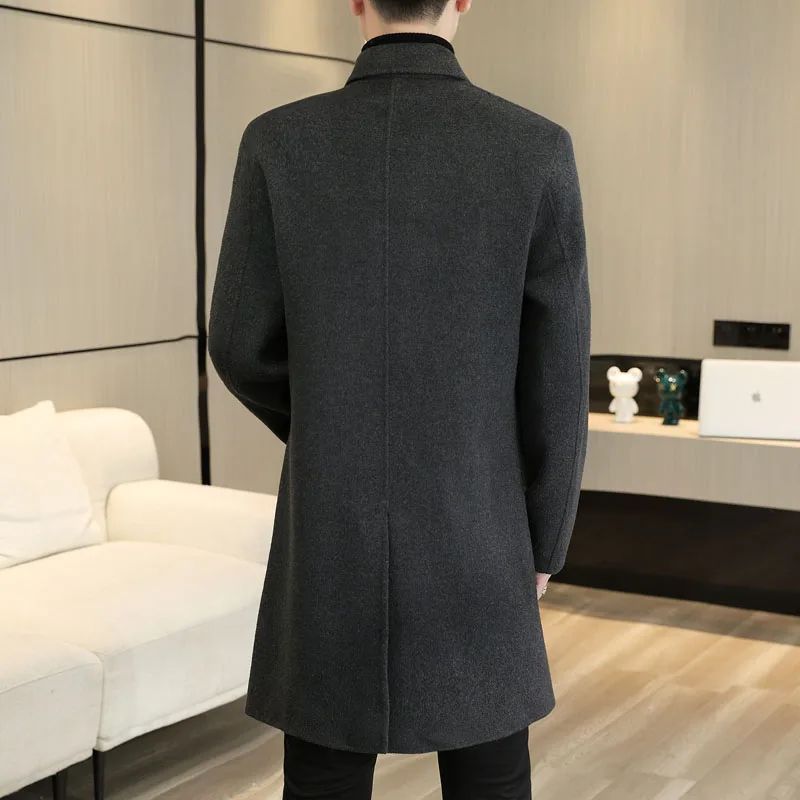
When selecting a topcoat for business settings, our mens wool overcoat collection offers exceptional options that provide the perfect blend of warmth and professional appearance. The topcoat should enhance your business attire without overwhelming it—complementing rather than competing with your suit or blazer.
7. Mastering Layering: Creating Depth with Light Topcoats
Effective layering transforms your light topcoat from simple outerwear to a crucial element in a sophisticated ensemble. The fundamental principle—thin to thick, light to heavy—ensures comfort and proper drape.
Begin with lightweight, body-skimming layers closest to your skin, gradually increasing thickness with each additional layer:
– Base layer: T-shirt, dress shirt, or light sweater
– Mid layer: Cardigan, vest, lightweight jacket, or blazer
– Outer layer: Your light topcoat
To avoid unwanted bulk, pay careful attention to the cut of each piece. Each layer should fit comfortably over the previous without stretching or straining. Simultaneously, avoid excessive room that creates bunching or distorts the topcoat’s clean lines.
Proper proportion between layers creates visual harmony. Generally:
– Shirt should extend slightly beyond sweater sleeves
– Blazer or suit jacket should extend beyond sweater but remain shorter than topcoat
– Topcoat should be proportioned according to short vs long coats guide standards
Create visual interest through texture variation rather than bold patterns. A smooth topcoat over a lightly textured sweater and crisp shirt creates subtle depth without overwhelming the eye. This approach maintains sophistication while adding dimensional interest.
For temperature regulation, consider materials carefully. Merino wool, fine cotton, and cashmere blend provide warmth without bulk, while breathable fabrics prevent overheating as you move between indoor and outdoor environments.
8. Seasonal Styling: Adapting Your Light Topcoat Year-Round
The versatility of light topcoats extends across multiple seasons with thoughtful adaptation. By adjusting your layering strategy and accompanying pieces, one quality topcoat can serve you through changing conditions.
Early Fall Approach
As summer transitions to fall, pair your topcoat with:
– Lightweight merino sweaters or cotton knits
– Medium-weight chinos or wool trousers
– Minimal layering underneath
– Seasonal colors like burgundy, olive, or rust in accessories
Deep Winter Strategy
When temperatures drop significantly:
– Maximize base layers with thermal options when needed
– Add substantial mid-layers like heavy sweaters or quilted vests
– Consider cashmere scarves and leather gloves as functional accessories
– Layer effectively without compromising the topcoat’s clean silhouette
Spring Transitions
As weather warms:
– Return to lighter interior layers
– Introduce brighter colors underneath the neutral topcoat
– Consider rolling or pushing up coat sleeves for a relaxed feel
– Pair with lighter-weight trousers and shoes
Summer Evenings
Even in summer, coastal locations or evening events might call for light outerwear:
– Wear open over light shirting with no middle layer
– Choose breathable linen or cotton trousers
– Skip heavy accessories entirely
– Keep the look relaxed and appropriate for evening temperature drops
For optimal year-round utility, select a topcoat weight that suits your typical regional climate, consulting our perfect winter coat length guide for proper proportions. Remember that light topcoats aren’t designed for extreme weather but rather for transitional seasons and moderate conditions.
9. Accessorizing Your Light Topcoat: The Finishing Touches
Thoughtfully selected accessories transform a basic topcoat ensemble into a distinctive personal statement. Each accessory should complement rather than compete with your coat while adding functional benefits.
Scarves
The natural companion to any topcoat, scarves offer both practicality and style:
– Materials: Cashmere provides luxurious warmth; wool offers durability; silk creates elegant formality
– Folds: The Parisian knot works universally well with topcoats; drape loosely for casual looks
– Colors: Choose complementary or subtle contrasting shades to your coat; solids for patterned coats, patterns for solid coats
Gloves
Quality gloves complete a refined winter look:
– Leather types: Smooth calf leather for formal settings; suede or pebbled leather for casual wear
– Fit: Should be snug without restricting movement
– Colors: Brown and black remain most versatile; burgundy and navy offer subtle character
– Linings: Cashmere or wool linings add warmth without bulk
Hats
The right hat balances proportion with your topcoat:
– Casual options: Wool beanies or flat caps for relaxed looks
– Formal choices: Felt fedoras or trilbys complement business attire
– Proportion: Consider face shape and coat style—wider brims balance longer coats
Bags
Your daily carry should match your coat’s level of refinement:
– Briefcases: Structured leather for formal business settings
– Messenger bags: For smart-casual work environments
– Weekenders: Leather or canvas for casual weekend topcoat styles
– Color harmony: Leather goods should generally coordinate with shoes

For formal ensembles, subtle pocket squares and minimal lapel pins can add personality without overwhelming the clean lines of your topcoat. Remember that accessories should enhance rather than distract from your overall appearance.
10. Light Topcoat Outfits for Special Occasions
Outfit 13: Wedding Guest
For daytime ceremonies, pair your light topcoat with a sharply tailored suit in an appropriate seasonal fabric. Navy or charcoal suits work universally well, complemented by a crisp white or subtle patterned shirt. Add a tasteful tie that references the wedding’s color scheme without matching too literally. Complete with polished oxford shoes and minimal accessories like a simple watch and understated cufflinks.
Outfit 14: Cocktail Event
Evening social functions call for refined elegance. Layer your light topcoat over dark separates—try a navy blazer with charcoal trousers or vice versa. Incorporate subtle pattern mixing, perhaps with a micropatterned shirt under a solid jacket. Accessories should introduce minimal color through a pocket square or knit tie. Complete with polished shoes in brown or black depending on your outfit’s undertones.
Outfit 15: Cultural Event
Theater premieres, gallery openings, and similar cultural gatherings call for smart-casual sophistication. Pair your light topcoat with well-fitted dark jeans or chinos, a button-down shirt, and an unstructured blazer or cardigan. Suede chukkas or loafers add appropriate refinement without formality. This balance communicates cultural appreciation without appearing overdressed.
Outfit 16: First Impression
Whether for important meetings or promising first dates, your light topcoat can create a memorable impression. Layer it over an outfit one step above what the occasion requires—for casual meetings, add a blazer; for formal ones, ensure impeccable suit coordination. Focus on immaculate grooming and perfect fit rather than flashy details. The confidence of appearing appropriately polished creates lasting positive impressions.
For these special moments, topcoats from our mens dress coat collection provide the perfect finishing touch, elevating your appearance with subtle sophistication that communicates attention to detail.
Mens Black Overcoat, Mens Black Wool Coat, Mens Wool Overcoat
$339.18 Select options This product has multiple variants. The options may be chosen on the product pageMens Grey Overcoat, Mens Wool Blend Coat, Mens Wool Overcoat
$201.28 Select options This product has multiple variants. The options may be chosen on the product pageMens Herringbone Coat, Mens Long Overcoat, Mens Wool Overcoat
Price range: $197.16 through $203.69 Select options This product has multiple variants. The options may be chosen on the product pageMens Long Overcoat, Mens Topcoats
Price range: $189.40 through $196.88 Select options This product has multiple variants. The options may be chosen on the product pageMens Dress Coat, Mens Long Overcoat
$76.76 Select options This product has multiple variants. The options may be chosen on the product pageMens Long Overcoat, Mens Wool Overcoat
$259.00 Select options This product has multiple variants. The options may be chosen on the product page
11. How to Care for Your Light Topcoat
Proper maintenance ensures your investment piece delivers years of sophisticated service. Different materials require specific approaches to cleaning and storage.
For wool and wool-blend topcoats:
– Brush regularly with a clothing brush to remove surface dirt and debris
– Spot clean small stains immediately with a damp cloth
– Dry clean only when truly necessary, typically once per season with normal wear
– Allow 24 hours rest between wearings to release wrinkles and moisture
For cotton and cotton-blend topcoats:
– Brush after wearing to maintain appearance
– Treat water-based stains quickly with a clean, damp cloth
– Follow manufacturer guidelines for cleaning—some cotton blends can be professionally wet-cleaned rather than dry cleaned
– Address oil-based stains immediately with professional cleaning
Proper storage prevents damage and maintains shape:
– Use broad, wooden hangers that support the shoulders properly
– Button the top button during storage to maintain structure
– Allow adequate space between garments to prevent crushing
– Store in breathable garment bags, never in plastic
– Add cedar elements to deter moths and absorb moisture
For extended off-season storage, have your coat professionally cleaned first, then store in a cool, dry place away from direct sunlight. This prevents unseen stains from setting and protects the fabric’s color and integrity over time.
12. Street Style Inspiration: Real Men Wearing Light Topcoats
Contemporary men’s style continues to embrace the light topcoat with refreshing versatility. On city streets from London to Tokyo, stylish men are creating distinctive interpretations of this classic garment.
The oversized topcoat trend continues to evolve, with slightly roomier cuts worn over streamlined basics. This proportional play creates modern silhouettes while maintaining sophistication. Look for topcoats with strong shoulders but relaxed bodies for this contemporary aesthetic.
Creative layering dominates current street style approaches. Forward-thinking men combine unexpected elements like technical outerwear under traditional topcoats or incorporate athletic-inspired pieces with tailored outerwear. These juxtapositions create distinctive personal style while honoring the topcoat’s inherent elegance.
Color experimentation beyond traditional neutrals appears increasingly in street style photography. Subtle shades like olive, burgundy, and muted blue offer character while maintaining versatility. These colors work particularly well in casual contexts where traditional formality rules are relaxed.
Across different body types, today’s style leaders demonstrate thoughtful proportion and fit. Taller men often select slightly shorter topcoats to create balance, while broader frames benefit from clean, vertical lines without excess fabric. The universal principle remains consistent: proper fit creates the foundation for successful styling regardless of body type.
For practical style guidance and visual examples, exploring resources like how to wear an overcoat provides additional inspiration from style experts.
13. Can a Light Topcoat Be Worn With Very Casual Clothes?
Absolutely! The juxtaposition of formal outerwear with casual basics creates some of today’s most interesting menswear combinations. The key lies in intentional styling that appears deliberate rather than mismatched.
For successful casual pairings, maintain balance by following these principles:
– Keep casual elements clean and high-quality (premium t-shirts, well-fitted jeans)
– Ensure color harmony between casual pieces and your topcoat
– Maintain proportion with slimmer casual pieces under a structured coat
– Add one refined element besides the coat (quality watch, leather sneakers)
Particularly successful casual combinations include:
– Light topcoat + white t-shirt + dark jeans + minimal leather sneakers
– Light topcoat + solid hoodie + wool trousers + leather boots
– Light topcoat + chambray shirt + chinos + desert boots
This high-low mix creates visual interest while demonstrating style confidence. The topcoat elevates casual basics, while relaxed elements make formal outerwear more approachable for everyday settings.
14. What’s the Difference Between a Light Topcoat, Overcoat, and Trench Coat?
These classic outerwear pieces serve different functions despite their superficial similarities:
| Feature | Light Topcoat | Overcoat | Trench Coat |
|---|---|---|---|
| Weight | 2-3 pounds | 3-5+ pounds | 2-3 pounds |
| Typical Length | Mid-thigh to knee | Knee or below | Mid-thigh to below knee |
| Materials | Lightweight wool, cotton | Heavy wool, cashmere | Cotton gabardine, polyester |
| Design Elements | Minimalist, clean lines | Substantial collar, heavier construction | Belt, storm flaps, epaulets |
| Traditional Use | Multi-season versatility | Winter warmth | Rain protection |
| Styling Formality | Highly versatile | More formal | Smart-casual to business |
Light topcoats offer versatile, multi-season wear with cleaner lines and lighter construction. Overcoats provide substantial winter protection with heavier materials and often more structured designs. Trench coats feature distinctive military-inspired details and traditionally provide weather protection.
When choosing between them, consider your climate, typical usage, and personal style. Light topcoats offer greatest versatility across seasons and formality levels, while the others excel in specific conditions.
15. Is It Appropriate to Wear a Light Topcoat with Athletic Wear?
The topcoat-with-athleisure look represents one of modern menswear’s most interesting developments. When executed thoughtfully, this combination creates sophisticated casual style perfect for urban environments.
For successful athleisure pairings:
– Choose premium athletic pieces with minimal branding
– Focus on monochromatic or complementary color schemes
– Ensure athletic pieces fit well without bagging or sagging
– Add one refined element like leather accessories or quality footwear
Athletic pieces that pair especially well with topcoats include:
– Premium joggers in wool blends or structured cotton
– Minimal leather or suede sneakers without bright colors
– Technical zip-ups in solid neutral colors
– Fine-gauge performance sweaters without visible logos
Items to avoid combining with topcoats:
– Performance shorts or very casual sweatpants
– Running shoes or athletic footwear with bright colors
– Athletic tops with large logos or team affiliations
– Performance gear with technical details like reflective strips
This contemporary pairing works best in casual urban settings rather than formal environments, creating an effortlessly modern aesthetic that balances refinement with comfort.
16. Light Topcoats for Different Body Types: Finding Your Perfect Style
Your physique should guide specific topcoat choices to ensure the most flattering fit and proportion.
For taller men (over 6‘2”):
– Consider longer topcoats that balance your height
– Horizontal details like belts can create proportion
– Three-button styles add visual interest to the vertical line
– Patterns like subtle checks can add dimension
For shorter men (under 5‘8”):
– Shorter topcoats ending at mid-thigh create better proportion
– Vertical elements like seaming create elongating lines
– Single-breasted styles reduce visual bulk
– Monochromatic outfits under the coat extend the visual line
For athletic builds:
– Ensure adequate room through shoulders and chest without excess fabric at waist
– Consider slightly tapered silhouettes that honor your natural V-shape
– Pay special attention to arm holes that accommodate developed upper arms
For larger builds:
– Structured shoulders create pleasing proportion
– Single-breasted closures minimize bulk at the midsection
– Dark solid colors create a streamlined appearance
– Proper length (perfect coat length for height) ensures balanced proportions
Common tailoring modifications that optimize fit include:
– Sleeve shortening/lengthening to achieve proper proportion
– Taking in side seams for a more defined waist
– Shoulder adjustments for proper alignment
– Button repositioning for optimal closure
Remember that topcoat fit should accommodate your typical layering strategy—if you frequently wear suits or blazers underneath, ensure your topcoat provides appropriate room.
17. Outfit Ideas for Unique Light Topcoat Colors
Outfit 17: Statement Burgundy Topcoat
A rich burgundy topcoat makes a sophisticated statement when paired thoughtfully. Balance this distinctive color with neutral foundations—try charcoal trousers, a light gray sweater, and white shirt. Complete with black leather shoes and minimal accessories. This approach allows the coat’s rich color to command attention while maintaining refined balance.
Outfit 18: Forest Green Topcoat
This uncommon yet versatile shade creates natural harmony when paired with earth tones. Layer a forest green topcoat over a camel sweater, white shirt, and dark brown trousers. Cognac leather accessories complete this naturally sophisticated palette. The combination creates subtle richness perfect for fall and winter without appearing overly trendy.
Outfit 19: Soft Caramel Topcoat
Warmer than classic camel, a soft caramel topcoat pairs beautifully with navy, cream, and burgundy. Try it over a cream rollneck sweater, navy trousers, and burgundy leather accessories. This combination balances warmth and depth for a distinctive yet versatile appearance. The result feels both contemporary and timeless.
Outfit 20: Checked or Patterned Topcoat
When wearing a patterned topcoat, simplify everything else to maintain sophistication. Pair a subtly checked coat with solid neutral layers—perhaps a charcoal sweater, white shirt, and dark trousers. Keep accessories minimal and complementary to the coat’s pattern colors. This approach lets the pattern’s character shine without creating visual competition.
When exploring beyond core neutrals, maintain versatility by choosing subdued versions of colors that complement your existing wardrobe. Subtle tones rather than bright variations ensure maximum wearability while still offering distinctive character.
18. When Should You Wear a Light Topcoat vs. Other Outerwear?
Light topcoats shine in specific conditions and contexts where their unique properties offer ideal protection and style.
Temperature-wise, light topcoats typically perform best in ranges from 40-60°F (4-15°C). Below this range, heavier overcoats provide necessary warmth; above it, lighter options like blazers or no outerwear become more appropriate. The topcoat’s middle-weight construction makes it ideal for fall and spring in most climates.
From a formality perspective, light topcoats offer remarkable versatility. They provide appropriate refinement for:
– Business professional environments
– Social occasions requiring smart-casual to formal attire
– Cultural events with elevated dress expectations
– Evening dining in upscale establishments
Alternative outerwear becomes more appropriate in specific circumstances:
– Pea coats for maritime or very casual settings
– Parkas or technical outerwear for severe weather conditions
– Leather jackets for casual, edgy styling
– Quilted or puffer jackets for outdoor-focused casual activities
The light topcoat’s greatest strength lies in its adaptability across both formality levels and seasonal conditions, making it an excellent primary outerwear investment for men with varied lifestyle needs.
19. How Many Light Topcoats Should a Man Own?
The ideal topcoat wardrobe depends on your lifestyle, climate, and personal style preferences. Consider these guidelines:
For essential coverage (occasional wear):
– One versatile option in navy or charcoal wool
– Choose a classic single-breasted style with minimal details
– Focus on quality construction and proper fit above all else
For a core collection (regular rotation):
– Primary neutral (navy or charcoal) for maximum versatility
– Secondary neutral (camel or light gray) for variety
– Consider different weights for seasonal adaptation
For an extended wardrobe (style enthusiast):
– Core neutrals in different weights and lengths
– One statement piece in burgundy, green, or pattern
– Specialty options like formal black for evening events
When building your collection, prioritize based on:
– Your typical dress code requirements
– Local climate conditions
– Storage space availability
– Budget allocation for quality over quantity
Remember that one exceptional topcoat that fits perfectly will serve you better than multiple inferior options. Quality, fit, and versatility should always take precedence over quantity.
20. Which Shoes Best Complement a Light Topcoat?
Footwear creates the foundation of your topcoat ensemble, and selecting appropriate styles ensures harmonious proportion from head to toe.
For formal topcoat outfits:
– Oxford shoes provide timeless elegance for business and formal events
– Whole-cut or cap-toe designs offer clean, sophisticated lines
– Black leather for most formal occasions, dark brown for slightly relaxed formality
– Polished finish rather than matte or pebbled textures
For smart-casual combinations:
– Derby shoes offer versatility across business-casual environments
– Monk straps provide distinctive character while maintaining refinement
– Brogues add textural interest for tweed or textured topcoats
– Brown, burgundy, or oxblood colors complement most topcoat shades
For casual topcoat styling:
– Chelsea boots blend sleek design with casual comfort
– Chukka boots in suede or leather add relaxed sophistication
– Minimalist leather sneakers in white or earth tones
– Loafers for transitional seasons and milder conditions
Color coordination guidelines:
– Match leather shoes to leather accessories when possible
– Brown shoes complement camel, green, and burgundy topcoats
– Black shoes work best with charcoal, navy, and black topcoats
– Suede introduces textural variety while softening formal outfits
The formality of your footwear should generally align with your overall outfit’s formality level, creating visual coherence from top to bottom.




